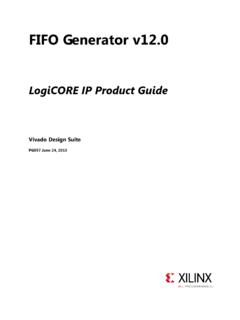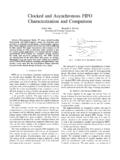Transcription of FIFO Architecture, Functions, and Applications - TI.com
1 1 fifo architecture , Functions, and ApplicationsSCAA042 ANovember 1999 2 IMPORTANT NOTICET exas Instruments and its subsidiaries (TI) reserve the right to make changes to their productsor to discontinue any product or service without notice, and advise customers to obtain the latestversion of relevant information to verify, before placing orders, that information being relied onis current and complete. All products are sold subject to the terms and conditions of sale suppliedat the time of order acknowledgement, including those pertaining to warranty, patentinfringement, and limitation of warrants performance of its semiconductor products to the specifications applicable at thetime of sale in accordance with TI s standard warranty.
2 Testing and other quality controltechniques are utilized to the extent TI deems necessary to support this warranty. Specific testingof all parameters of each device is not necessarily performed, except those mandated bygovernment Applications USING SEMICONDUCTOR PRODUCTS MAY INVOLVEPOTENTIAL RISKS OF DEATH, PERSONAL INJURY, OR SEVERE PROPERTY ORENVIRONMENTAL DAMAGE ( CRITICAL Applications ). TI SEMICONDUCTORPRODUCTS ARE NOT DESIGNED, AUTHORIZED, OR WARRANTED TO BE SUITABLE FORUSE IN LIFE-SUPPORT DEVICES OR SYSTEMS OR OTHER CRITICAL OF TI PRODUCTS IN SUCH Applications IS UNDERSTOOD TO BE FULLYAT THE CUSTOMER S order to minimize risks associated with the customer s Applications , adequate design andoperating safeguards must be provided by the customer to minimize inherent or assumes no liability for Applications assistance or customer product design.
3 TI does notwarrant or represent that any license, either express or implied, is granted under any patent right,copyright, mask work right, or other intellectual property right of TI covering or relating to anycombination, machine, or process in which such semiconductor products or services might beor are used. TI s publication of information regarding any third party s products or services doesnot constitute TI s approval, warranty or endorsement 1999, Texas Instruments IncorporatediiiContentsTitlePageAbstract 1.. Introduction1.. fifo Types2.. Exclusive Read/Write FIFOs3.. Concurrent Read/Write FIFOs3.. Metastability of Synchronizing Circuits3.. Asynchronous FIFOs6.. Synchronous FIFOs9.. fifo Architectures11.
4 Fall-Through FIFOs11.. Architecture11.. Advantages and Drawbacks13.. FIFOs With Static Memory13.. Architecture13.. Advantages and Drawbacks14.. FIFOs From TI14.. Features14.. Data Outputs With Latches14.. Synchronization of Flags15.. Edges of Outputs16.. Extending Word Width16.. Extending Memory Depth17.. Application Examples18.. Asynchronous Operation of Exclusive Read/Write FIFOs18.. Connection of Peripherals to Processors20.. Block Transfer of Data23.. Programmable Delay24.. Collecting Data Before an Event24.. Collecting Data Before and After an Event26.. Summary29.. Acknowledgment29.. ivList of IllustrationsFigureTitlePage1 first -In first -Out Data Flow2.. 2 Synchronization of External Signal3.. 3 Timing Diagram for the Metastable State4.
5 4 Block Diagram of Two-Level Synchronization4.. 5 Timing Diagram for Two-Level Synchronization5.. 6 Signals of fifo With Single-Level Synchronization (Recorded for 15 Hours Under Worst-Case Conditions)5.. 7 Signals of TI SN74 ACT7807 fifo With Three-Level Synchronization(Recorded for 15 Hours Under Worst-Case Conditions)6.. 8 Connections of an Asynchronous FIFO6.. 9 Timing Diagram for Asynchronous fifo of Length 47.. 10 Asynchronism When Resetting FULL Signal8.. 11 Connections of a Synchronous FIFO9.. 12 Timing Diagram for a Synchronous fifo of Length 410.. 13 Circuitry of 4 5 Fall-Through FIFO11.. 14 Timing Diagram of 4 5 Fall-Through fifo in Figure 1312.. 15 Circular fifo With Two Pointers13.. 16 Block Diagram of fifo With Static Memory14.
6 17 Waveforms on fifo Outputs14.. 18 Signals in Synchronous fifo SN74 ACT7881 With Multilevel Synchronization of Status Outputs15.. 19 Extending Word Width of Asynchronous FIFOs16.. 20 Extending Word Width of Synchronous FIFOs17.. 21 Extending Memory Depth of Synchronous FIFOs17.. 22 Timing Conditions for WRITE CLOCK and READ CLOCK18.. 23 Synchronizing Circuit for Generating WRITE CLOCK and READ CLOCK Signals18.. 24 Timing of Signals in Synchronizing Circuit19.. 25 Connection of Unidirectional Peripheral With the SN74 ACT7881 FIFO20.. 26 Connection of Bidirectional Peripheral With the SN74 ACT2235 FIFO21.. 27 Connection of Bidirectional Peripheral With DMA and SN74 ACT2235 FIFO22.. 28 Video Signal With Picture Information and Porch22.
7 29 Digitizing and Compressing a Video Signal With the TMS320C30 Signal Processor23.. 30 Block Transfer of Data With Synchronous SN74 ACT7881 FIFO23.. 31 Programmable Digital Delay With the SN74 ACT788124.. 32 Timing of Signals in Programmable Digital Delay With the SN74 ACT788124.. 33 Collecting Data Before an Event With the SN74 ACT788125.. 34 Timing of Device Shown in Figure 3325.. 35 Collecting Data Before and After an Event With the SN74 ACT788126.. 36 Timing of Signals in the SN74 ACT7881 During Initialization and Start of Data Capture27.. 37 Timing of Signals in the SN74 ACT7881 at End of Data Capture and Start of Readout28.. 1 AbstractFirst-in first -out memories (FIFOs) have progressed from fairly simple logic functions to high-speed buffers incorporatinglarge blocks of SRAM.
8 This application report takes a detailed look at the evolution of fifo device functionality and at thearchitecture and Applications of fifo devices from Texas Instruments (TI ). The first part presents the different functionsof FIFOs and the resulting types that are found. The second part deals with current fifo architectures and the different waysin which they work. Finally, some application examples are given to illustrate the use of FIFOs from the TI product every item of digital equipment there is exchange of data between printed circuit boards (PCBs). Intermediate storage orbuffering always is necessary when data arrive at the receiving PCB at a high rate or in batches, but are processed slowly of this kind also can be observed in everyday life (for example, a queue of customers at the checkout point in asupermarket or cars backed up at traffic lights).
9 The checkout point in a supermarket works slowly and constantly, while thenumber of customers coming to it is very irregular. If many customers want to pay at the same time, a queue forms, which worksby the principle of first come, first served. The backup at traffic lights is caused by the sporadic arrival of the cars, the trafficlights allowing them to pass through only in electronic systems, buffers of this kind also are advisable for interfaces between components that work at different speedsor irregularly. Otherwise, the slowest component determines the operating speed of all other components involved in a compact-disk player, for instance, the speed of rotation of the disk determines the data rate. To make the reproduced soundfluctuations independent of the speed, the data rate of the A/D converter is controlled by a quartz crystal.
10 The different datarates are compensated by buffering. In this way, the sound fluctuations are largely independent of the speed at which fifo is a special type of buffer. The name fifo stands for first in first out and means that the data written into the bufferfirst comes out of it first . There are other kinds of buffers like the LIFO (last in first out), often called a stack memory, and theshared memory. The choice of a buffer architecture depends on the application to be can be implemented with software or hardware. The choice between a software and a hardware solution depends onthe application and the features desired. When requirements change, a software fifo easily can be adapted to them bymodifying its program, while a hardware fifo may demand a new board layout.


















